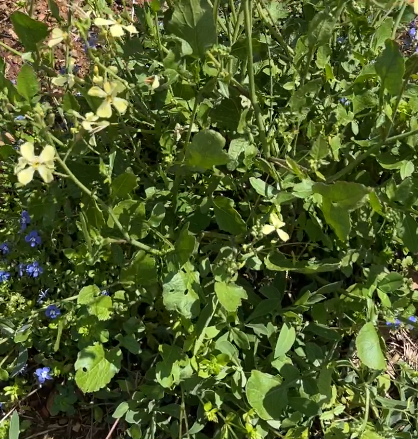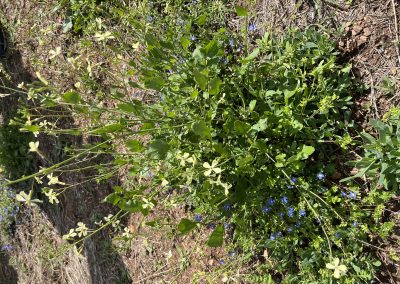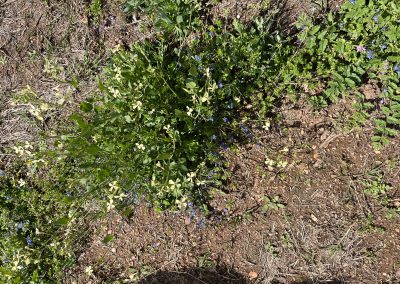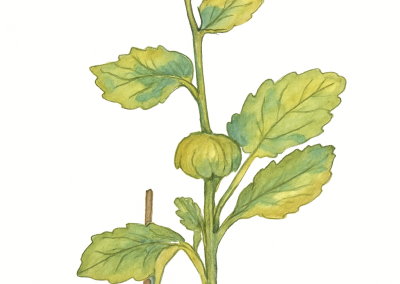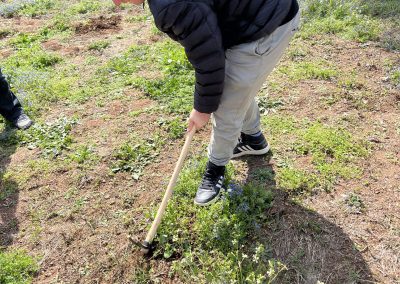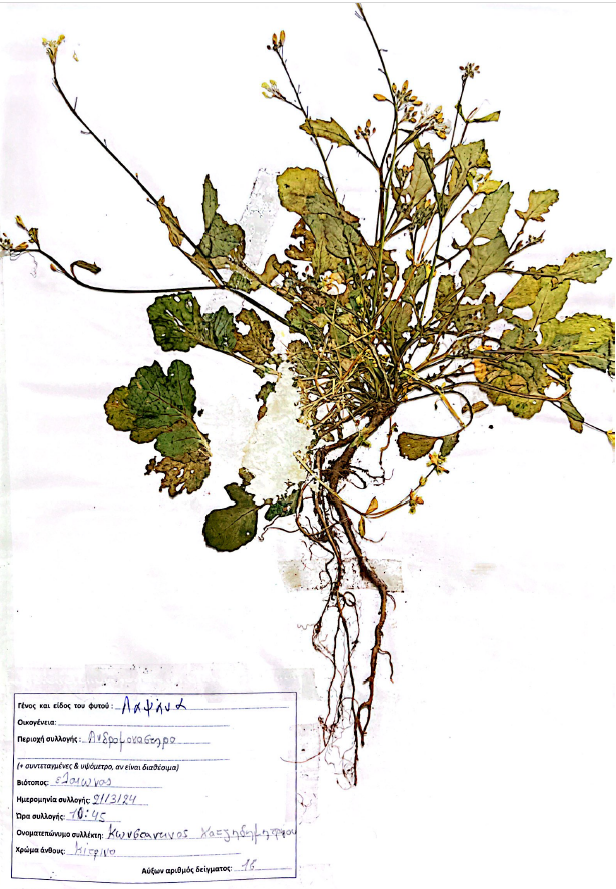Sinapis arvensis
Scientific description
Scientific name: Sinapis arvensis
Common name: Wild Mustard
Kingdom: Plants
Syntax: Magnoliophyta
Class: Dicotyledons (Magnoliopsida)
Order: Brassicales
Family: Brassicaceae
Genus: Mustard (Sinapis) L.
Species: Sinapis arvensis
Origin:
Native to temperate regions of Europe, Asia, and North Africa.
Ecology:
Annual plant, part of a genus including perennial, herbaceous plants native to Europe, West Asia, and North Africa. Common in Greece, considered one of the worst wheat weeds, mainly in lowlands where it grows abundantly.
Description:
Four bright yellow petals over mid-green leaves. Stems with downward-pointing white hairs and red segments at joints. Seedlings have spiny leaves with prominent veins. Basal rosette growth. Lower leaves lobed and toothed, upper leaves alternate, sessile to short-stalked, becoming shorter up the stem. Flowers ~1 cm, cross-shaped arrangement.
Propagation:
Hermaphroditic flowers, can self-pollinate. Pollination by wind or insects.
Usage:
Known to ancient Greeks; Dioscorides called it a glowing plant. Young plants eaten by humans and animals; somewhat harmful when blooming. Medicinal. Sinapis alba seeds produce mustard ("napy" mentioned by Theophrastus).
Σινάπι ή Λαψάνα ή βρούβες
Βασίλειο: Φυτά
Συνομοταξία: Αγγειόσπερμα (Magnoliophyta)
Ομοταξία: Δικοτυλήδονα (Magnoliopsida)
Τάξη: Brassicales
Οικογένεια: Σταυρανθή (Brassicaceae)
Γένος: Σινάπι (Sinapis) L.
Είδος: Sinapis arvensis
Καταγωγή:
Εύκρατες περιοχές Ευρώπης, Ασίας και Βόρειας Αφρικής.
Οικολογία:
Ετήσιο φυτό, μέρος γένους με πολυετή ποώδη φυτά. Κοινό στην Ελλάδα, ένα από τα χειρότερα ζιζάνια σιταριού, κυρίως σε πεδινές περιοχές.
Περιγραφή:
Τέσσερα φωτεινά κίτρινα πέταλα πάνω από μεσοπράσινα φύλλα. Βλαστοί με λευκές τρίχες προς τα κάτω και κόκκινα τμήματα στις ενώσεις. Σπορόφυτα με αγκαθωτά φύλλα και εμφανείς φλέβες. Βασική ροζέτα. Κατώτερα φύλλα λοβωτά και οδοντωτά, ανώτερα εναλλασσόμενα, άμισχα έως κοντόμισχα. Τα φύλλα μικραίνουν προς τα πάνω. Άνθη ~1 cm σε σχήμα σταυρού.
Πολλαπλασιασμός:
Ερμαφρόδιτα άνθη, αυτογονιμοποιούνται. Επικονίαση με άνεμο ή έντομα.
Χρήση:
Γνωστό στους αρχαίους Έλληνες, Διοσκουρίδης: «λαμπύζων φυτό». Τρώγεται νεαρό από ανθρώπους και ζώα, γίνεται επιβλαβές όταν ανθίσει. Φαρμακευτικό. Από Sinapis alba παράγεται μουστάρδα («νάπυ» Θεόφραστου).
Nom scientifique : Sinapis arvensis
Nom commun : Moutarde des champs
Règne : Plantes
Syntaxe : Magnoliophyta
Classe : Dicotylédones (Magnoliopsida)
Ordre : Brassicales
Famille : Brassicacées
Genre : Moutarde (Sinapis) L.
Espèce : Sinapis arvensis
Origine:
Régions tempérées d’Europe, Asie et Afrique du Nord.
Écologie:
Annuelle, genre comprenant des plantes herbacées vivaces d’Europe, Asie occidentale et Afrique du Nord. Lapslane, commun en Grèce, l’une des pires mauvaises herbes du blé, surtout en plaine.
Description:
Quatre pétales jaunes sur feuilles vertes. Tiges avec poils blancs vers le bas et segments rouges aux jonctions. Jeunes feuilles épineuses avec nervures proéminentes, rosette basale. Feuilles inférieures lobées/dentées, supérieures alternes, sessiles à court-pétiole. Fleurs ~1 cm, disposition en croix.
Propagation:
Fleurs hermaphrodites, autopollinisation possible. Pollinisation par vent ou insectes.
Utilisation:
Connu des Grecs anciens, Dioscoride: « plante lumineuse ». Jeune plante comestible, nocive en floraison. Médicinale. Sinapis alba produit la moutarde (« napy » mentionné par Théophraste).
Denumire științifică: Sinapis arvensis
Denumire comună: Muștar sălbatic
Regn: Plantae
Diviziune: Magnoliophyta
Clasă: Magnoliopsida
Ordin: Brassicales
Familie: Brassicaceae
Gen: Sinapis
Specie: Sinapis arvensis
Origine:
Regiuni temperate din Europa, Asia și Africa de Nord.
Ecologie:
Anuală, parte a unui gen cu plante erbacee perene, native din Europa, Asia de Vest și Africa de Nord. Comună în Grecia, considerată una dintre cele mai dăunătoare buruieni de grâu, în special în câmpii.
Descriere:
Patru petale galben intens deasupra frunzelor verde-mijlociu. Tulpini cu peri albi orientați în jos și segmente roșiatice la noduri. Frunze tinere spinoase cu nervuri proeminente, rozetă bazală. Frunze inferioare lobate și zimțate, superioare alternante, sesile sau cu pețiol scurt. Frunze mai scurte pe măsură ce urcă pe tulpină. Florile ~1 cm, în formă de cruce.
Înmulțire:
Flori hermafrodite, autopolenizare posibilă. Polenizare prin vânt sau insecte.
Utilizare:
Cunoscut de grecii antici, Dioscoride: „planta care arde”. Plante tinere comestibile, devine nocivă la înflorire. Medicinală. Din Sinapis alba se produce muștar („napi” menționat de Teofrast).
Creative writing inspired by Sinapis arvensis
Sinapis arvensis — The Legend of the Yellow Star
In the days of ancient Greece, there lived a young shepherdess named Lapsana. She was known for her gentle nature and deep connection to the land. Lapsana roamed the hillsides with her flock, always surrounded by wild plants and flowers, which she loved dearly. Among them was a small, yellow-flowered plant that she cared for above all others—wild mustard.
One summer, a terrible drought struck the land. The streams dried up, the crops withered, and people began to starve. Lapsana, seeing her village suffer, prayed to Demeter, the goddess of the harvest, to save them. Demeter, moved by the girl's sincere love for the earth, appeared before her. The goddess gave her a simple task: to spread the seeds of the wild mustard plant across the barren land.
Without hesitation, Lapsana gathered the tiny mustard seeds and scattered them far and wide. To the amazement of the villagers, the mustard plants flourished in the dry soil, their bright yellow flowers bringing new life to the land. The wild mustard, though humble in appearance, grew rapidly and provided both food and medicine, saving the village from famine.
From that day forward, the wild mustard plant, known as "Sinapis arvensis," became a symbol of resilience and hope. The people named the plant after Lapsana, calling it Λαψάνα in her honor. It became a reminder that even the smallest, most overlooked plant could bring salvation in times of need.


